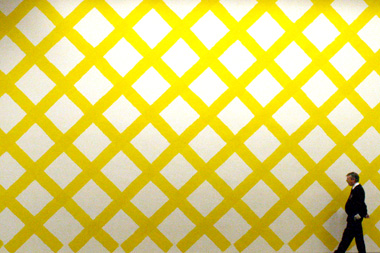 |
View of Douglas Hyde Gallery, Martin Creed exhibition, including Martin Creed: Work No.841 Plywood, 2007 and Martin Creed: Work No.840 Emulsion on Wall, 2007; courtesy Douglas Hyde Gallery; photo Laura McGovern |
How much appreciation one can get from the Douglas Hyde Gallery exhibition Martin Creed is determined by how much the viewer already knows about artist Creed. The work on display is neither interesting nor engaging. It recreates the many exhibitions there have been where the likes of perfectly aligned piles of plywood vie for attention with the likes of pieces of paper coloured with marker, or geometric grids painted directly on the walls. The artwork on display is then neither original nor thought-provoking; in fact one might even leave the exhibition thoroughly drained for the exhausting effort of trying to attach some appreciation and understanding to the work on display.
Since 1987 Creed has numbered all of his works, with a mere descriptive subtitle. The exhibition in the Douglas Hyde Gallery in Trinity College is titled, quite aptly and abruptly then, Martin Creed, and there is a sense that to expect more is contradictory to the aims and intentions of both the artist and the exhibition. The accompanying handout has little to say about the works on display here, reverting back to a description of Creed’s Turner Prize-winning entry in an attempt to establish this artist’s significance.
Martin Creed won the Turner Prize in 2001 with a piece entitled, Work # 277, Lights going on and off, which quite clearly consisted of the lights in a particular room in the Tate being turned on and off at five-second intervals. His work was praised for its strength and wit and the artist commended for his audacity in submitting just one work. However, it seems that although he uses the same artistic language in his artwork in the Douglas Hyde Gallery, he fails to convey those characteristics which ensured his earlier success.
What springs to mind upon seeing this exhibition is a phrase coined by Liverpudlian art critic John Byrne: Airport art.[ 1 ] This idea describes art that leaves the viewer with the same effect as an airport terminal: exhaustive blandness. Byrne argues that airport terminals are devoid of any cultural or contextual markers and that similar feelings are created when art in the untold number of biennials around the world tries to engage with the country it’s featured in. The result is a “timeless, limitless, transcendent, non-culturally specific and, in a paradoxically ironic twist, plainly ‘international’” [ 2 ] style.
 |
Martin Creed: Work No.840 emulsion on eall, 2007, installation shot; courtesy Douglas Hyde Gallery; photo Laura McGovern |
This idea can be applied to Creed’s work in terms of its site-specificity. Two walls in the Douglas Hyde Gallery have been painted ( Work # 840 emulsion on wall and Work # 843 dark blue emulsion ), and another piece has nails stuck into a wall at varying lengths ( Work # 701 nails ), carrying on a trend in Creed’s work to be site-specific in his exhibition work.
 |
Martin Creed: Work No.701 nails, 2007, courtesy Douglas Hyde Gallery. Photo: Laura McGovern |
 |
Martin Creed: Work No.382 highlights, 5 part, highlighter on paper, 2004; courtesy Douglas Hyde Gallery; photo Laura McGovern |
In sympathy with Byrne’s critique of art at biennials, Creed’s work also has little to do with the cultural or contextual signifiers of its site, rendering the need for site-specitificity moot. This may even make Creed’s work akin to some strain of legal graffitti, as he leaves his own mark on walls across the world without actually reflecting on or responding to those walls themselves. Creed says that his work stems from “a desire to communicate with other people” [ 3 ]; an emotional practice, and yet for the casual viewer there can be no communication with this cold, austere and empty art. The only communication seems to be the dissemination of Creed’s message of nothing.
In the 1950s and ’60s, when minimalism began, a lot of artists used this language to disrupt the traditional conventions of critique and display, and to question institutional authority. Forty to fifty years later, these ideas have been fully explored and exhausted, so a viewer might be forgiven for wondering why they are being replayed by an artist in the twenty-first century. In fact, not only are the ideas being repeated but the works themselves are, also: Work # 841 plywood, is a pile of plywood boards stacked on top of one another which could easily be attributed to Carl Andre, and Work # 745 pen on paper, Work # 679 acrylic on canvas and Work # 840 emulsion on wall, all give a very definite nod to artists such as Barnett Newman and Agnes Martin.
 |
Martin Creed: Works No.680-691 Mixed Media on Paper, 12 part, 1986; courtesy of Douglas Hyde Gallery; photo Laura McGovern |
It appears that much of what is happening in this exhibition is smoke and mirrors. Creed uses an established language of minimalism to say, as his work does, minimalist things. For an artist who supposedly critiques and questions the authority of the institution – albeit an idea of his work put forward by the Turner Prize committee – his very reputation is build on institutional validation.
Hollie Kearns
1 Byrne, John, ‘Feedback-Loop’: Liverpool Biennial 04 Still Under Construction, Official press corps of the 2004 Liverpool Biennial
2 Ibid.
3 Exhibition Hand-out